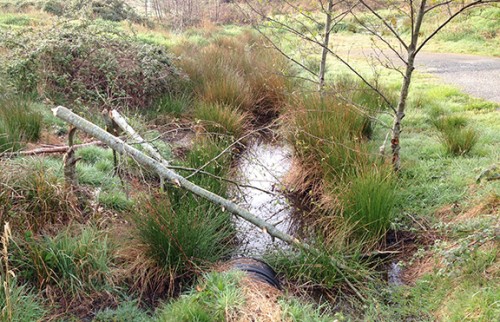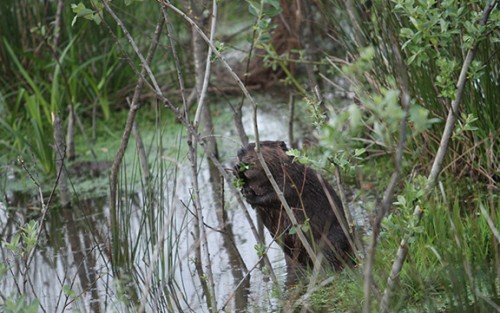The waterway formerly known as Ditch Creek, trickling into Stanley Marsh on the east side of Seaside, is undergoing an incredible transformation—or perhaps incredible is the wrong word. In fact, it is exactly what you would expect to see after you take a few simple steps to invite beavers into the landscape.
The story started about five years ago, when a local landowner sought permission to expand his business footprint at the Cannon Beach junction. That required building in a wetland—a heavily degraded wetland, overgrown with blackberry and other weeds, but a wetland just the same. In order to do so, he was required by law to compensate for the loss of that wetland by creating, preserving, or enhancing wetland elsewhere in the area.
[wc_row][wc_column size=”one-half” position=”first”]

This is probably a relative of the beavers currently working Stanley Marsh; Neal Maine caught this beaver in action at Thompson Creek a couple of years ago.
[/wc_column][wc_column size=”one-half” position=”last”]
[/wc_column][/wc_row]
Meanwhile North Coast Land Conservancy had long sought to restore Stanley Marsh—centerpiece of its Stanley Marsh and Thompson Creek Habitat Reserve—to its historic condition as a Sitka spruce swamp. Beginning in the 1940s, when the land was cleared for pasture, and through subsequent years when it became a horse arena and was ditched and drained for a possible housing development, Stanley Marsh became choked with invasive reed canary grass, limiting its usefulness to native wildlife.
 It was suggested to the developer that he consider compensating for the loss of the wetlands at his place of business by enhancing the wetland at Stanley Marsh. Doug Ray of Carex Consulting is a former board member and big fan of NCLC; he was able to create a plan for his client that matched NCLC’s vision of stewardship for Stanley Marsh property: rather than bringing in lots of heavy equipment to reshape the land according to a human’s idea of restoration, take simple steps to create the conditions that would encourage nature’s own wetland engineers—beavers—to do it. “A few discrete surgical actions, hardly any digging, to create some instant habitat” is what Doug envisioned. It was a radical concept—one initially resisted by the managing agencies whose approval was required. Ultimately NCLC and Carex talked those agencies into giving it a try. Levees were breached, letting water flow. Pieces of woody debris were placed in strategic locations. And old fill material was creatively repurposed to craft uplands where spruce trees could thrive.
It was suggested to the developer that he consider compensating for the loss of the wetlands at his place of business by enhancing the wetland at Stanley Marsh. Doug Ray of Carex Consulting is a former board member and big fan of NCLC; he was able to create a plan for his client that matched NCLC’s vision of stewardship for Stanley Marsh property: rather than bringing in lots of heavy equipment to reshape the land according to a human’s idea of restoration, take simple steps to create the conditions that would encourage nature’s own wetland engineers—beavers—to do it. “A few discrete surgical actions, hardly any digging, to create some instant habitat” is what Doug envisioned. It was a radical concept—one initially resisted by the managing agencies whose approval was required. Ultimately NCLC and Carex talked those agencies into giving it a try. Levees were breached, letting water flow. Pieces of woody debris were placed in strategic locations. And old fill material was creatively repurposed to craft uplands where spruce trees could thrive.
 Before long—just as we had hoped—a family of beavers moved in: probably descendants of the Thompson Creek beavers that left after their dam failed in 2013. The project included placement of woody debris across the creek as a courtesy for the beavers, giving them the foundation on which to start a dam. The beavers ignored it and began building their own dam from scratch three feet upstream.
Before long—just as we had hoped—a family of beavers moved in: probably descendants of the Thompson Creek beavers that left after their dam failed in 2013. The project included placement of woody debris across the creek as a courtesy for the beavers, giving them the foundation on which to start a dam. The beavers ignored it and began building their own dam from scratch three feet upstream.
Now beavers are maintaining and expanding not one but at least three dams in and around Stanley Marsh, creating an ever-expanding pond system that just months ago was a weed-choked pasture. “Lo and behold, there’s a 50-foot dam in the middle of the marsh,” Doug says. “They’re adding to it every night.” Ditch Creek can’t really be called a creek anymore, he adds. “It’s just a linear feature of this much larger beaver pond complex that’s growing every night. It’s definitely not a ‘ditch creek’ anymore. It’s like Beavertopia.”
“Beavers know precisely what to do, with the least bioenergentics, to build the best habitat.”
That non-native reed canary grass that was choking the marsh? In the ordinary course of their business, the beavers are eradicating it. They’re eating it. They’re digging it up and using it as a foundation for their dams. And the water those dams are holding back is inundating the marsh and will ultimately drown out the grass, recharging the groundwater in the area and creating a nursery for young coho salmon.

The beavers’ wetland engineering is all taking place in and around the city of Seaside: enhancing views and improving the water quality for the citizens.
For their part, the beavers are just taking care of themselves, creating and growing ponds that allow them to travel by water and avoid terrestrial predators. In that process, they’re also creating refuges for juvenile salmon, shorebirds such as snipes, songbirds such as bluebirds that use the hummocks in the marsh—all those species and many more have been spotted in the newly inundated marsh this spring. “This diversity of life—it can’t be there without what beavers do,” Doug says. “They’re a keystone species.”
If you hadn’t figured it out already, all involved (including staff at the land management agencies) are thrilled with the outcome; the project’s success has exceed all expectations. “It’s just this miracle that results from letting the beavers do their work,” as Doug puts it.
“I kept my faith in the beavers.”



Comments